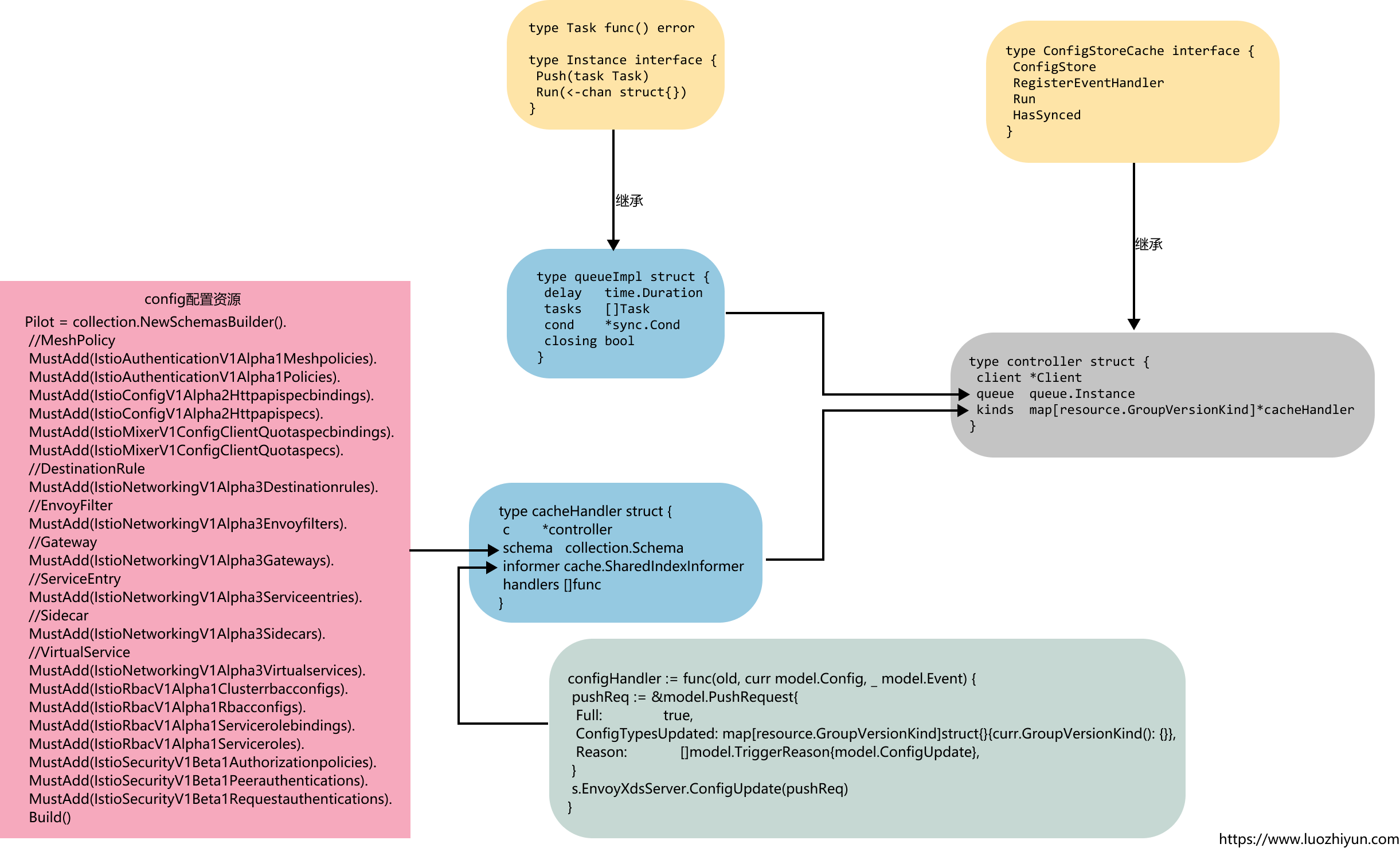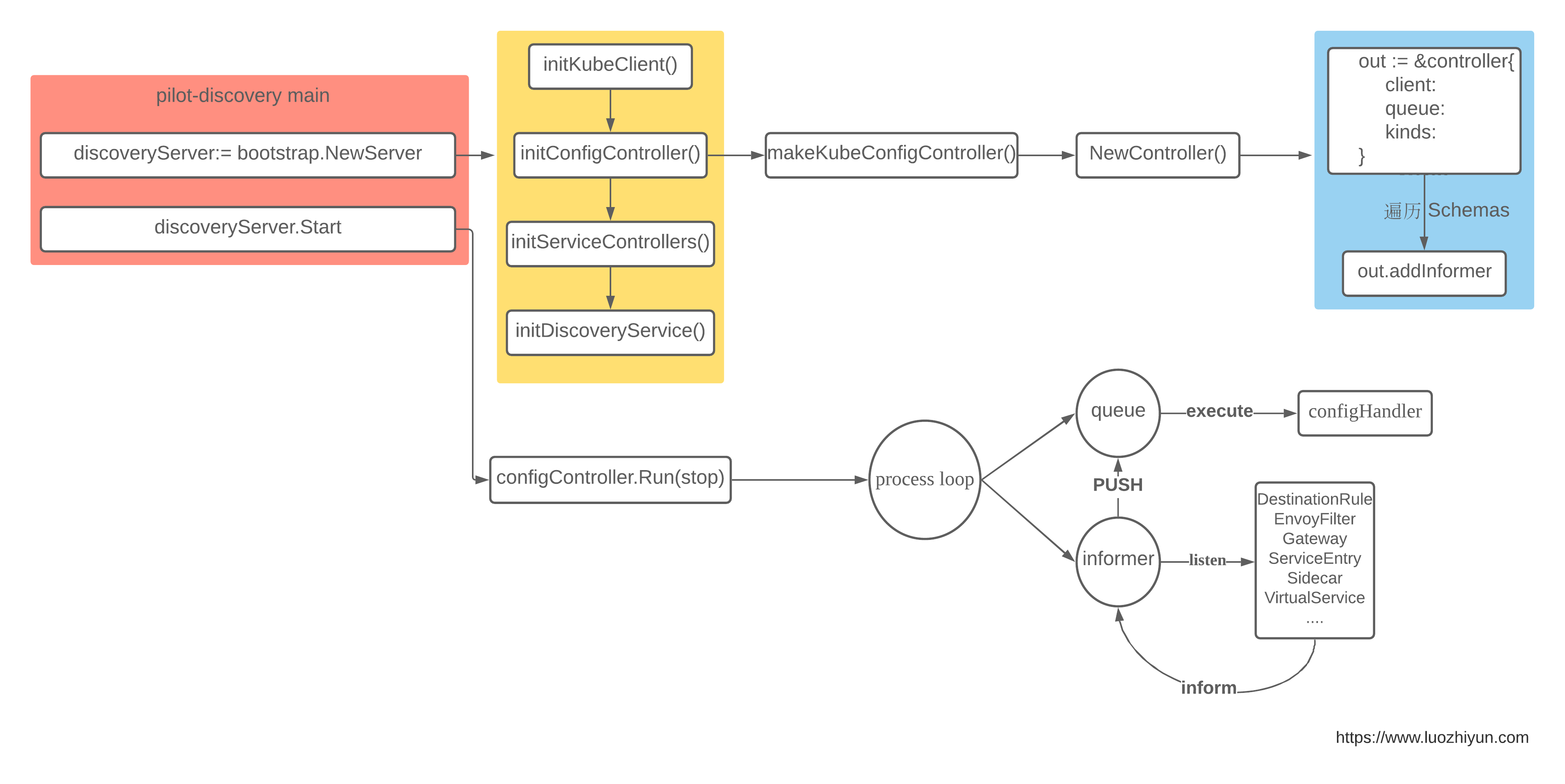3.深入Istio:Pilot配置規則ConfigController
阿新 • • 發佈:2020-11-28
> 轉載請宣告出處哦~,本篇文章釋出於luozhiyun的部落格:https://www.luozhiyun.com
>
> 本文使用的Istio原始碼是 release 1.5。
Config Controller用於管理各種配置資料,包括使用者建立的流量管理規則和策略。Istio目前支援三種類型的Config Controller:
* MCP:是一種網路配置協議,用於隔離Pilot和底層平臺(檔案系統、K8s),使得Pilot無須感知底層平臺的差異,從而達到解耦的目的。
* File:通過監視器週期性地讀取本地配置檔案,將配置規則快取在記憶體中,並維護配置的增加、更新、刪除事件,當快取由變化的時候,非同步通知執行事件回撥。
* Kubernetes:基於k8s的Config發現利用了k8s Informer的監聽能力。在k8s叢集中,Config以CustomResource的形式存在。通過監聽apiserver配置規則資源,維護所有資源的快取Store,並觸發事件處理回撥函式。
## ConfigController初始化
ConfigController是在initConfigController中被初始化的,在initConfigController方法中會呼叫makeKubeConfigController進行controller的初始化。
```go
func (s *Server) makeKubeConfigController(args *PilotArgs) (model.ConfigStoreCache, error) {
//建立configClient
configClient, err := controller.NewClient(args.Config.KubeConfig, "", collections.Pilot,
args.Config.ControllerOptions.DomainSuffix, buildLedger(args.Config), args.Revision)
if err != nil {
return nil, multierror.Prefix(err, "failed to open a config client.")
}
//建立controller,併為config資源設定監聽
return controller.NewController(configClient, args.Config.ControllerOptions), nil
}
func NewController(client *Client, options controller2.Options) model.ConfigStoreCache {
log.Infof("CRD controller watching namespaces %q", options.WatchedNamespace)
// The queue requires a time duration for a retry delay after a handler error
out := &controller{
client: client,
queue: queue.NewQueue(1 * time.Second),
kinds: make(map[resource.GroupVersionKind]*cacheHandler),
}
// add stores for CRD kinds
//獲取所有的CRD型別
for _, s := range client.Schemas().All() {
//為每一種Config資源都建立一個informer,監聽所有的Config資源
out.addInformer(s, options.WatchedNamespace, options.ResyncPeriod)
}
return out
}
```
初始化完controller之後會獲取所有的CRD型別,為每一種Config資源都建立一個informer,監聽所有的Config資源。
```go
Pilot = collection.NewSchemasBuilder().
//MeshPolicy
MustAdd(IstioAuthenticationV1Alpha1Meshpolicies).
MustAdd(IstioAuthenticationV1Alpha1Policies).
MustAdd(IstioConfigV1Alpha2Httpapispecbindings).
MustAdd(IstioConfigV1Alpha2Httpapispecs).
MustAdd(IstioMixerV1ConfigClientQuotaspecbindings).
MustAdd(IstioMixerV1ConfigClientQuotaspecs).
//DestinationRule
MustAdd(IstioNetworkingV1Alpha3Destinationrules).
//EnvoyFilter
MustAdd(IstioNetworkingV1Alpha3Envoyfilters).
//Gateway
MustAdd(IstioNetworkingV1Alpha3Gateways).
//ServiceEntry
MustAdd(IstioNetworkingV1Alpha3Serviceentries).
//Sidecar
MustAdd(IstioNetworkingV1Alpha3Sidecars).
//VirtualService
MustAdd(IstioNetworkingV1Alpha3Virtualservices).
MustAdd(IstioRbacV1Alpha1Clusterrbacconfigs).
MustAdd(IstioRbacV1Alpha1Rbacconfigs).
MustAdd(IstioRbacV1Alpha1Servicerolebindings).
MustAdd(IstioRbacV1Alpha1Serviceroles).
MustAdd(IstioSecurityV1Beta1Authorizationpolicies).
MustAdd(IstioSecurityV1Beta1Peerauthentications).
MustAdd(IstioSecurityV1Beta1Requestauthentications).
Build()
```
這裡定義好了所有要用到的Config資源型別,主要涉及網路配置、認證、鑑權、策略管理等。
## ConfigController事件處理
下面我們看一下controller定義:
```go
type controller struct {
client *Client
queue queue.Instance
kinds map[resource.GroupVersionKind]*cacheHandler
}
```
client是呼叫`controller.NewClient`初始化的client;queue會在Informer監聽到資源的變動的時候將資料push到佇列中,controller在呼叫run方法的時候單獨執行一個執行緒執行queue中的函式;kinds在呼叫addInformer方法的時候初始化進去。
queue.Instance的定義如下:
```go
type Task func() error
type Instance interface {
Push(task Task)
Run(<-chan struct{})
}
type queueImpl struct {
delay time.Duration
tasks []Task
cond *sync.Cond
closing bool
}
```
queueImpl繼承了Instance介面,在呼叫push方法的時候,會將Task放入到tasks陣列中,並在呼叫Run方法的時候消費陣列中的資料。
controller繼承了ConfigStoreCache介面:
```go
type ConfigStoreCache interface {
ConfigStore
// 註冊規則事件處理函式
RegisterEventHandler(kind resource.GroupVersionKind, handler func(Config, Config, Event))
// 執行
Run(stop <-chan struct{})
// 配置快取是否已同步
HasSynced() bool
}
```
ConfigStoreCache通過RegisterEventHandler介面為上面提到的配置資源都註冊事件處理函式,通過Run方法啟動控制器。
```go
func (c *controller) Run(stop <-chan struct{}) {
log.Infoa("Starting Pilot K8S CRD controller")
go func() {
cache.WaitForCacheSync(stop, c.HasSynced)
//單獨啟動一個執行緒執行queue裡面的函式
c.queue.Run(stop)
}()
for _, ctl := range c.kinds {
go ctl.informer.Run(stop)
}
<-stop
log.Info("controller terminated")
}
```
在呼叫Run方法的時候會單獨的啟動一個執行緒呼叫queue的Run方法消費佇列中的資料,並遍歷所有的配置資訊,呼叫informer的Run方法開啟監聽。
監聽器的EventHandler通過如下程式碼註冊:
```go
func (c *controller) newCacheHandler(
schema collection.Schema,
o runtime.Object,
otype string,
resyncPeriod time.Duration,
lf cache.ListFunc,
wf cache.WatchFunc) *cacheHandler {
informer := cache.NewSharedIndexInformer(
&cache.ListWatch{ListFunc: lf, WatchFunc: wf}, o,
resyncPeriod, cache.Indexers{})
h := &cacheHandler{
c: c,
schema: schema,
informer: informer,
}
informer.AddEventHandler(
cache.ResourceEventHandlerFuncs{
AddFunc: func(obj interface{}) {
incrementEvent(otype, "add")
//將ADD事件傳送至佇列
c.queue.Push(func() error {
return h.onEvent(nil, obj, model.EventAdd)
})
},
UpdateFunc: func(old, cur interface{}) {
if !reflect.DeepEqual(old, cur) {
incrementEvent(otype, "update")
//將Update事件傳送至佇列
c.queue.Push(func() error {
return h.onEvent(old, cur, model.EventUpdate)
})
} else {
incrementEvent(otype, "updatesame")
}
},
DeleteFunc: func(obj interface{}) {
incrementEvent(otype, "delete")
//將Delete事件傳送至佇列
c.queue.Push(func() error {
return h.onEvent(nil, obj, model.EventDelete)
})
},
})
return h
}
```
當Config資源建立、更新、刪除時,EventHandler建立任務物件並將其傳送到任務佇列中,然後由任務處理執行緒處理。當對應的事件被呼叫的時候會觸發onEvent方法,會呼叫到cacheHandler的onEvent方法,最後設定完畢後將cacheHandler返回,controller會將此cacheHandler設定到kinds陣列中存下來。
下面我們看一下cacheHandler的定義:
```go
type cacheHandler struct {
c *controller
schema collection.Schema
informer cache.SharedIndexInformer
handlers []func(model.Config, model.Config, model.Event)
}
```
cacheHandler在上面初始化的時候,會傳入對應的controller、Schema、informer,然後在呼叫configController的RegisterEventHandler方法的時候會初始化對應的configHandler。
configController的RegisterEventHandler方法會在初始化DiscoveryService的時候呼叫initEventHandlers方法進行初始化:
```go
func (s *Server) initEventHandlers() error {
...
if s.configController != nil {
configHandler := func(old, curr model.Config, _ model.Event) {
pushReq := &model.PushRequest{
Full: true,
ConfigTypesUpdated: map[resource.GroupVersionKind]struct{}{curr.GroupVersionKind(): {}},
Reason: []model.TriggerReason{model.ConfigUpdate},
}
s.EnvoyXdsServer.ConfigUpdate(pushReq)
}
//遍歷所有的資源
for _, schema := range collections.Pilot.All() {
// This resource type was handled in external/servicediscovery.go, no need to rehandle here.
//ServiceEntry 這個資源不在這裡註冊,感興趣的朋友可以自己找一下
if schema.Resource().GroupVersionKind() == collections.IstioNetworkingV1Alpha3Serviceentries.
Resource().GroupVersionKind() {
continue
}
//註冊configHandler到configController中
s.configController.RegisterEventHandler(schema.Resource().GroupVersionKind(), configHandler)
}
}
return nil
}
```
initEventHandlers會呼叫collections.Pilot.All方法獲取所有的資源配置,然後遍歷呼叫RegisterEventHandler方法將configHandler函式註冊到cacheHandler的handlers中,至於configHandler函式做了什麼,我們到下一篇講XdsServer的時候再講。
這一部分的程式碼是比較繞的,這裡畫個圖理解一下吧。

整個執行流程為:

## 總結
至此,ConfigController的核心原理及工作流程就介紹完畢了。本篇主要講解了我們常用的Istio的Gateway、DestinationRule及VirtualService等配置是如何被Istio監聽到並作出相應改變的。希望大家能有所收穫。
## Reference
https://ruofeng.me/2018/11/08/how-does-istio-pilot-push-eds-config/
https://zhaohuabing.com/post/2019-10-21-pilot-discovery-code-analysi
https://www.servicemesher.com/blog/envoy-proxy-config-deep-dive/
https://www.cnblogs.com/163yun/p/8962
